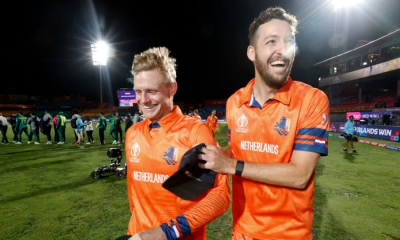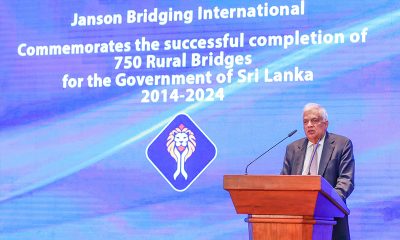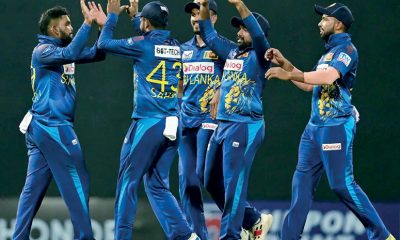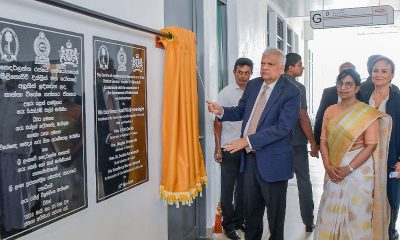Features
Miracles and other strange stories

(Excerpted from the Merrill. J. Fernando autobiography)
I believe in miracles. I believe that there is a divine hand in all the affairs of men. I believe that many of the good things that have happened to me to have been answers to prayer, whilst narrow escapes from disaster, on several occasions, the merciful hand of God.
In September 1976, whilst I was driving in Colombo, at the corner of Muttiah Park, about 200 metres from the Gangaramaya Temple, my car was hit by a truck. I have little or no memory about the accident itself, but I found myself seated on the pavement on the side of the road in a state of shock, not quite knowing what was going on. My car was a total wreck. Sometime later I was told that I had been pulled out of the car by passers-by. The only visible injury was a small gash on my back. However, later on at the hospital, it was discovered that a few of my ribs had also been broken.
Whilst I was awaiting treatment at the Accident Ward of the General Hospital, I saw Dr. Cabraal, the neurosurgeon, passing by. I told him about the accident and that I had no recollection of what had taken place. He told me that the erasure of that unpleasant memory was nature’s way of protecting me. In the meantime a young doctor, possibly an intern, who walked into the ward sutured the wound in my back, but to this day the site of the wound produces unpleasant sensations. My guess is that the wound was closed up without it being properly disinfected.
Whist all this was going on Dr. P. R. Anthonis, the well-known surgeon, arrived at the ward and said: “Merrill, you cannot stay here, I am taking you to Ratnam Hospital.” After admitting me to Ratnam’s, he called in Dr. Rienzie Pieris, the Orthopaedic Surgeon, who was then in government service. Rienzie took me in hand and after that first meeting we became lifelong friends. My sons who were holidaying at Merton bungalow at the time of the accident returned to Colombo and wanted to stay with me in hospital, but I insisted that they go back to school.
Divine deliverance
K. Selvanathan, the father of Mano and Hari, visited me in hospital and told me that he had seen the twisted heap of metal that had been my car and that it was a miracle that I had escaped with my life. He said: “Merrill, when you get out of hospital, you must work for God, to thank him for having saved your life.” I have never forgotten those words.
In July 1983, civil riots broke out all over Colombo. I was in office at that time with Leone Van Lier, from South Africa. Gangs of armed men were stopping cars, smashing up windscreens, and, if the occupants were Tamil, pulling them out and beating them. Petrol was being removed from cars by force and used to burn vehicles and buildings. It was a terrifying and lawless time.
Against the pleas of my staff, I decided to leave the office with Leone. I told them that I would pray and trust in God. Leone, a seasoned South African, was surprisingly calm as he had become familiar with civil strife in his country! I drove out of my office and found the road full of rioting gangs but about 100 metres away I spotted two naval officers on motorcycles. I quickly got my car behind their machines and traveled with that escort up to the next set of traffic lights, leaving the rioters behind. As we got to safety, both Leone and I realized that our naval escort had disappeared. Thinking about it later, and the unbelievably opportune appearance of the naval officers, I concluded that it was the intervention of the Lord on my behalf.
There was a somewhat similar episode some years later, when I was rushed to Durdans with an undiagnosed but serious medical condition. Over a couple of weeks in hospital I was administered a wide range of medications and subjected to numerous procedures, but my condition did not improve, whilst the various tests carried out on me failed to identity the problem. One evening, Pastor Dishan Wickremaratne, having found out that I was in hospital, arrived with his father, Pastor Colton and, together, prayed with me for over an hour. The next day I had recovered completely and was able to return home just two days later.
Immediately thereafter I left for Singapore and, at the New University Hospital, underwent a series of tests and subsequently had consultations with several doctors. However, there was no sign of illness, nor an indication of a medical condition which could have caused that bout of ill-health. Thinking about this chain of events some months later, I came to the realization that my recovery from an inexplicable illness was due to the power of prayer.
Netherlands – near disaster
I was on a business trip across Europe, during which I had to spend some time in the Netherlands. One morning, I traveled to Rotterdam by train to meet a customer and while walking from the station to the customer’s office, I stopped at a department store to buy refills for my pen. I had placed my leather briefcase on a counter with a mirror, on it and while removing the case, I accidentally knocked down the mirror, which shattered to pieces. Having apologized profusely to the shop staff for my clumsiness, I moved on.
When I finished my business with the customer, he suggested that we leave for a pre-arranged lunch, but I declined and caught an early train back. Traveling through The Hague, the speeding train suddenly derailed and several compartments, including the one I was in, toppled. A young couple sitting next to me suffered minor fractures whilst I smashed my knee on a hard surface. Ambulances arrived quickly and the medical staff started dispatching the injured to hospital, requesting all passengers to stay at the location till all had been attended to.
I could not afford to waste time as I had traveled thousands of miles to attend to important business issues. Avoiding the paramedics, I managed to scramble out of my compartment, which had fallen into a ditch, and limped across to the nearest highway where I flagged down a passing truck. The driver very kindly dropped me off at my hotel in Amsterdam.
My knee by then was badly swollen and painful, but I collected my bags and rode to the airport immediately to catch a flight to Munich, to meet another customer. After the meeting my customer took me to a doctor, who attended to my knee and, thereafter, I drove to Berlin for the next customer meeting.
The above events followed each other in very rapid succession and during that period my main focus was honouring my customer appointments, despite the accident and the injury. After my meeting in Berlin, I relaxed for a couple of days – on doctor’s orders, actually –and that rest gave me the opportunity for quiet reflection on that rapid chain of events.
My conclusion was that the whole episode could have ended very badly for me, but that I escaped, by God’s grace, relatively unscathed and was still able to conclude my business. Perhaps the broken mirror was an omen and a warning of what was to follow! However, at each stage, I was provided with a timely solution which, in my view, could only have been heaven sent.
A special relationship
Whilst I was in hospital recovering from my car accident in ‘ 76, the well-known Venerable Galaboda Gnanissara Thero, the “Podihamuduruwo” of the Gangaramaya Temple, visited me. He returned to me my neck chain, my ring, and my rosary, which I carry with me all the time. He had recovered them from the scene of the accident. With that first meeting, we developed a very special friendship.
Whenever I visited him at the temple, thereafter, he used to come out to the car and lead me into the premises, holding me by the hand. I always hastened to open the car door myself lest he opened it for me, as I did not think that was appropriate. He would take me into the greeting room and insist that I sit down and make myself comfortable. He would not allow me to take off my shoes although it is customary to do so when one is in the presence of a Buddhist priest or in a temple. He would also lead me around the temple, still with my shoes on. Much to my embarrassment, he introduces me to all we meet as the Christian who helps all religions!
Every year we conduct a ‘pirith’ ceremony at our Peliyagoda premises for the Buddhist members of our staff. Irrespective of all his other commitments, this ceremony is always presided over by Podihamuduruwo. He waits for a couple of hours after the ceremony commences and then leaves with me, as I am unable to maintain the traditional seated, cross-legged posture on the ground for very long.
I have tremendous respect for Podihamuduruwo, a dynamic leader and a person of vision. I have seen for myself the contribution he has made to uplifting underprivileged youth, with his vocational training centre in basic engineering and other technical skills.
In fact, many of the technicians in my plant at Peliyagoda were first trained at the Gangaramaya centre. I have assisted him in some of his ventures, such as the construction of housing for low-income families and also at the training centre. I never failed to contribute to the annual Gangaramaya Perahera and, once, at his request, participated in the construction of resting houses for pilgrims at the Kataragama Temple.
The Venerable Thero and I come from two completely different backgrounds; I from a middle class society on the western coast, rooted firmly in the Catholic faith, and he from a village farming community in the deep south, the power base of rural Sinhala Buddhists. But we discovered a commonality of ideas and ideals and a resonance in our personal philosophies, especially that of a shared sense of community responsibility. He too, like me, is a man with a highly-developed entrepreneurial spirit. Despite the mutual exclusivity in the respective positions we occupy in society, I an industrialist and he a leading Buddhist cleric, deep down, fundamentally, we are kindred spirits.
I was deeply distressed when Podihamuduruwo fell seriously ill. He was flown to Singapore for treatment and I visited him in hospital with Pastor Samson and, together, we prayed to Lord Jesus for his recovery. I fervently hope that this good and amazing man will be able to recover and return to the wonderful work he has been doing for the community. Our society sorely needs more people like him.
Features
The heart-friendly health minister

by Dr Gotabhya Ranasinghe
Senior Consultant Cardiologist
National Hospital Sri Lanka
When we sought a meeting with Hon Dr. Ramesh Pathirana, Minister of Health, he graciously cleared his busy schedule to accommodate us. Renowned for his attentive listening and deep understanding, Minister Pathirana is dedicated to advancing the health sector. His openness and transparency exemplify the qualities of an exemplary politician and minister.
Dr. Palitha Mahipala, the current Health Secretary, demonstrates both commendable enthusiasm and unwavering support. This combination of attributes makes him a highly compatible colleague for the esteemed Minister of Health.
Our discussion centered on a project that has been in the works for the past 30 years, one that no other minister had managed to advance.
Minister Pathirana, however, recognized the project’s significance and its potential to revolutionize care for heart patients.
The project involves the construction of a state-of-the-art facility at the premises of the National Hospital Colombo. The project’s location within the premises of the National Hospital underscores its importance and relevance to the healthcare infrastructure of the nation.
This facility will include a cardiology building and a tertiary care center, equipped with the latest technology to handle and treat all types of heart-related conditions and surgeries.
Securing funding was a major milestone for this initiative. Minister Pathirana successfully obtained approval for a $40 billion loan from the Asian Development Bank. With the funding in place, the foundation stone is scheduled to be laid in September this year, and construction will begin in January 2025.
This project guarantees a consistent and uninterrupted supply of stents and related medications for heart patients. As a result, patients will have timely access to essential medical supplies during their treatment and recovery. By securing these critical resources, the project aims to enhance patient outcomes, minimize treatment delays, and maintain the highest standards of cardiac care.
Upon its fruition, this monumental building will serve as a beacon of hope and healing, symbolizing the unwavering dedication to improving patient outcomes and fostering a healthier society.We anticipate a future marked by significant progress and positive outcomes in Sri Lanka’s cardiovascular treatment landscape within the foreseeable timeframe.
Features
A LOVING TRIBUTE TO JESUIT FR. ALOYSIUS PIERIS ON HIS 90th BIRTHDAY

by Fr. Emmanuel Fernando, OMI
Jesuit Fr. Aloysius Pieris (affectionately called Fr. Aloy) celebrated his 90th birthday on April 9, 2024 and I, as the editor of our Oblate Journal, THE MISSIONARY OBLATE had gone to press by that time. Immediately I decided to publish an article, appreciating the untiring selfless services he continues to offer for inter-Faith dialogue, the renewal of the Catholic Church, his concern for the poor and the suffering Sri Lankan masses and to me, the present writer.
It was in 1988, when I was appointed Director of the Oblate Scholastics at Ampitiya by the then Oblate Provincial Fr. Anselm Silva, that I came to know Fr. Aloy more closely. Knowing well his expertise in matters spiritual, theological, Indological and pastoral, and with the collaborative spirit of my companion-formators, our Oblate Scholastics were sent to Tulana, the Research and Encounter Centre, Kelaniya, of which he is the Founder-Director, for ‘exposure-programmes’ on matters spiritual, biblical, theological and pastoral. Some of these dimensions according to my view and that of my companion-formators, were not available at the National Seminary, Ampitiya.
Ever since that time, our Oblate formators/ accompaniers at the Oblate Scholasticate, Ampitiya , have continued to send our Oblate Scholastics to Tulana Centre for deepening their insights and convictions regarding matters needed to serve the people in today’s context. Fr. Aloy also had tried very enthusiastically with the Oblate team headed by Frs. Oswald Firth and Clement Waidyasekara to begin a Theologate, directed by the Religious Congregations in Sri Lanka, for the contextual formation/ accompaniment of their members. It should very well be a desired goal of the Leaders / Provincials of the Religious Congregations.
Besides being a formator/accompanier at the Oblate Scholasticate, I was entrusted also with the task of editing and publishing our Oblate journal, ‘The Missionary Oblate’. To maintain the quality of the journal I continue to depend on Fr. Aloy for his thought-provoking and stimulating articles on Biblical Spirituality, Biblical Theology and Ecclesiology. I am very grateful to him for his generous assistance. Of late, his writings on renewal of the Church, initiated by Pope St. John XX111 and continued by Pope Francis through the Synodal path, published in our Oblate journal, enable our readers to focus their attention also on the needed renewal in the Catholic Church in Sri Lanka. Fr. Aloy appreciated very much the Synodal path adopted by the Jesuit Pope Francis for the renewal of the Church, rooted very much on prayerful discernment. In my Religious and presbyteral life, Fr.Aloy continues to be my spiritual animator / guide and ongoing formator / acccompanier.
Fr. Aloysius Pieris, BA Hons (Lond), LPh (SHC, India), STL (PFT, Naples), PhD (SLU/VC), ThD (Tilburg), D.Ltt (KU), has been one of the eminent Asian theologians well recognized internationally and one who has lectured and held visiting chairs in many universities both in the West and in the East. Many members of Religious Congregations from Asian countries have benefited from his lectures and guidance in the East Asian Pastoral Institute (EAPI) in Manila, Philippines. He had been a Theologian consulted by the Federation of Asian Bishops’ Conferences for many years. During his professorship at the Gregorian University in Rome, he was called to be a member of a special group of advisers on other religions consulted by Pope Paul VI.
Fr. Aloy is the author of more than 30 books and well over 500 Research Papers. Some of his books and articles have been translated and published in several countries. Among those books, one can find the following: 1) The Genesis of an Asian Theology of Liberation (An Autobiographical Excursus on the Art of Theologising in Asia, 2) An Asian Theology of Liberation, 3) Providential Timeliness of Vatican 11 (a long-overdue halt to a scandalous millennium, 4) Give Vatican 11 a chance, 5) Leadership in the Church, 6) Relishing our faith in working for justice (Themes for study and discussion), 7) A Message meant mainly, not exclusively for Jesuits (Background information necessary for helping Francis renew the Church), 8) Lent in Lanka (Reflections and Resolutions, 9) Love meets wisdom (A Christian Experience of Buddhism, 10) Fire and Water 11) God’s Reign for God’s poor, 12) Our Unhiddden Agenda (How we Jesuits work, pray and form our men). He is also the Editor of two journals, Vagdevi, Journal of Religious Reflection and Dialogue, New Series.
Fr. Aloy has a BA in Pali and Sanskrit from the University of London and a Ph.D in Buddhist Philosophy from the University of Sri Lankan, Vidyodaya Campus. On Nov. 23, 2019, he was awarded the prestigious honorary Doctorate of Literature (D.Litt) by the Chancellor of the University of Kelaniya, the Most Venerable Welamitiyawe Dharmakirthi Sri Kusala Dhamma Thera.
Fr. Aloy continues to be a promoter of Gospel values and virtues. Justice as a constitutive dimension of love and social concern for the downtrodden masses are very much noted in his life and work. He had very much appreciated the commitment of the late Fr. Joseph (Joe) Fernando, the National Director of the Social and Economic Centre (SEDEC) for the poor.
In Sri Lanka, a few religious Congregations – the Good Shepherd Sisters, the Christian Brothers, the Marist Brothers and the Oblates – have invited him to animate their members especially during their Provincial Congresses, Chapters and International Conferences. The mainline Christian Churches also have sought his advice and followed his seminars. I, for one, regret very much, that the Sri Lankan authorities of the Catholic Church –today’s Hierarchy—- have not sought Fr.
Aloy’s expertise for the renewal of the Catholic Church in Sri Lanka and thus have not benefited from the immense store of wisdom and insight that he can offer to our local Church while the Sri Lankan bishops who governed the Catholic church in the immediate aftermath of the Second Vatican Council (Edmund Fernando OMI, Anthony de Saram, Leo Nanayakkara OSB, Frank Marcus Fernando, Paul Perera,) visited him and consulted him on many matters. Among the Tamil Bishops, Bishop Rayappu Joseph was keeping close contact with him and Bishop J. Deogupillai hosted him and his team visiting him after the horrible Black July massacre of Tamils.
Features
A fairy tale, success or debacle

Sri Lanka-Singapore Free Trade Agreement
By Gomi Senadhira
senadhiragomi@gmail.com
“You might tell fairy tales, but the progress of a country cannot be achieved through such narratives. A country cannot be developed by making false promises. The country moved backward because of the electoral promises made by political parties throughout time. We have witnessed that the ultimate result of this is the country becoming bankrupt. Unfortunately, many segments of the population have not come to realize this yet.” – President Ranil Wickremesinghe, 2024 Budget speech
Any Sri Lankan would agree with the above words of President Wickremesinghe on the false promises our politicians and officials make and the fairy tales they narrate which bankrupted this country. So, to understand this, let’s look at one such fairy tale with lots of false promises; Ranil Wickremesinghe’s greatest achievement in the area of international trade and investment promotion during the Yahapalana period, Sri Lanka-Singapore Free Trade Agreement (SLSFTA).
It is appropriate and timely to do it now as Finance Minister Wickremesinghe has just presented to parliament a bill on the National Policy on Economic Transformation which includes the establishment of an Office for International Trade and the Sri Lanka Institute of Economics and International Trade.
Was SLSFTA a “Cleverly negotiated Free Trade Agreement” as stated by the (former) Minister of Development Strategies and International Trade Malik Samarawickrama during the Parliamentary Debate on the SLSFTA in July 2018, or a colossal blunder covered up with lies, false promises, and fairy tales? After SLSFTA was signed there were a number of fairy tales published on this agreement by the Ministry of Development Strategies and International, Institute of Policy Studies, and others.
However, for this article, I would like to limit my comments to the speech by Minister Samarawickrama during the Parliamentary Debate, and the two most important areas in the agreement which were covered up with lies, fairy tales, and false promises, namely: revenue loss for Sri Lanka and Investment from Singapore. On the other important area, “Waste products dumping” I do not want to comment here as I have written extensively on the issue.
1. The revenue loss
During the Parliamentary Debate in July 2018, Minister Samarawickrama stated “…. let me reiterate that this FTA with Singapore has been very cleverly negotiated by us…. The liberalisation programme under this FTA has been carefully designed to have the least impact on domestic industry and revenue collection. We have included all revenue sensitive items in the negative list of items which will not be subject to removal of tariff. Therefore, 97.8% revenue from Customs duty is protected. Our tariff liberalisation will take place over a period of 12-15 years! In fact, the revenue earned through tariffs on goods imported from Singapore last year was Rs. 35 billion.
The revenue loss for over the next 15 years due to the FTA is only Rs. 733 million– which when annualised, on average, is just Rs. 51 million. That is just 0.14% per year! So anyone who claims the Singapore FTA causes revenue loss to the Government cannot do basic arithmetic! Mr. Speaker, in conclusion, I call on my fellow members of this House – don’t mislead the public with baseless criticism that is not grounded in facts. Don’t look at petty politics and use these issues for your own political survival.”
I was surprised to read the minister’s speech because an article published in January 2018 in “The Straits Times“, based on information released by the Singaporean Negotiators stated, “…. With the FTA, tariff savings for Singapore exports are estimated to hit $10 million annually“.
As the annual tariff savings (that is the revenue loss for Sri Lanka) calculated by the Singaporean Negotiators, Singaporean $ 10 million (Sri Lankan rupees 1,200 million in 2018) was way above the rupees’ 733 million revenue loss for 15 years estimated by the Sri Lankan negotiators, it was clear to any observer that one of the parties to the agreement had not done the basic arithmetic!
Six years later, according to a report published by “The Morning” newspaper, speaking at the Committee on Public Finance (COPF) on 7th May 2024, Mr Samarawickrama’s chief trade negotiator K.J. Weerasinghehad had admitted “…. that forecasted revenue loss for the Government of Sri Lanka through the Singapore FTA is Rs. 450 million in 2023 and Rs. 1.3 billion in 2024.”
If these numbers are correct, as tariff liberalisation under the SLSFTA has just started, we will pass Rs 2 billion very soon. Then, the question is how Sri Lanka’s trade negotiators made such a colossal blunder. Didn’t they do their basic arithmetic? If they didn’t know how to do basic arithmetic they should have at least done their basic readings. For example, the headline of the article published in The Straits Times in January 2018 was “Singapore, Sri Lanka sign FTA, annual savings of $10m expected”.
Anyway, as Sri Lanka’s chief negotiator reiterated at the COPF meeting that “…. since 99% of the tariffs in Singapore have zero rates of duty, Sri Lanka has agreed on 80% tariff liberalisation over a period of 15 years while expecting Singapore investments to address the imbalance in trade,” let’s turn towards investment.
Investment from Singapore
In July 2018, speaking during the Parliamentary Debate on the FTA this is what Minister Malik Samarawickrama stated on investment from Singapore, “Already, thanks to this FTA, in just the past two-and-a-half months since the agreement came into effect we have received a proposal from Singapore for investment amounting to $ 14.8 billion in an oil refinery for export of petroleum products. In addition, we have proposals for a steel manufacturing plant for exports ($ 1 billion investment), flour milling plant ($ 50 million), sugar refinery ($ 200 million). This adds up to more than $ 16.05 billion in the pipeline on these projects alone.
And all of these projects will create thousands of more jobs for our people. In principle approval has already been granted by the BOI and the investors are awaiting the release of land the environmental approvals to commence the project.
I request the Opposition and those with vested interests to change their narrow-minded thinking and join us to develop our country. We must always look at what is best for the whole community, not just the few who may oppose. We owe it to our people to courageously take decisions that will change their lives for the better.”
According to the media report I quoted earlier, speaking at the Committee on Public Finance (COPF) Chief Negotiator Weerasinghe has admitted that Sri Lanka was not happy with overall Singapore investments that have come in the past few years in return for the trade liberalisation under the Singapore-Sri Lanka Free Trade Agreement. He has added that between 2021 and 2023 the total investment from Singapore had been around $162 million!
What happened to those projects worth $16 billion negotiated, thanks to the SLSFTA, in just the two-and-a-half months after the agreement came into effect and approved by the BOI? I do not know about the steel manufacturing plant for exports ($ 1 billion investment), flour milling plant ($ 50 million) and sugar refinery ($ 200 million).
However, story of the multibillion-dollar investment in the Petroleum Refinery unfolded in a manner that would qualify it as the best fairy tale with false promises presented by our politicians and the officials, prior to 2019 elections.
Though many Sri Lankans got to know, through the media which repeatedly highlighted a plethora of issues surrounding the project and the questionable credentials of the Singaporean investor, the construction work on the Mirrijiwela Oil Refinery along with the cement factory began on the24th of March 2019 with a bang and Minister Ranil Wickremesinghe and his ministers along with the foreign and local dignitaries laid the foundation stones.
That was few months before the 2019 Presidential elections. Inaugurating the construction work Prime Minister Ranil Wickremesinghe said the projects will create thousands of job opportunities in the area and surrounding districts.
The oil refinery, which was to be built over 200 acres of land, with the capacity to refine 200,000 barrels of crude oil per day, was to generate US$7 billion of exports and create 1,500 direct and 3,000 indirect jobs. The construction of the refinery was to be completed in 44 months. Four years later, in August 2023 the Cabinet of Ministers approved the proposal presented by President Ranil Wickremesinghe to cancel the agreement with the investors of the refinery as the project has not been implemented! Can they explain to the country how much money was wasted to produce that fairy tale?
It is obvious that the President, ministers, and officials had made huge blunders and had deliberately misled the public and the parliament on the revenue loss and potential investment from SLSFTA with fairy tales and false promises.
As the president himself said, a country cannot be developed by making false promises or with fairy tales and these false promises and fairy tales had bankrupted the country. “Unfortunately, many segments of the population have not come to realize this yet”.
(The writer, a specialist and an activist on trade and development issues . )

























